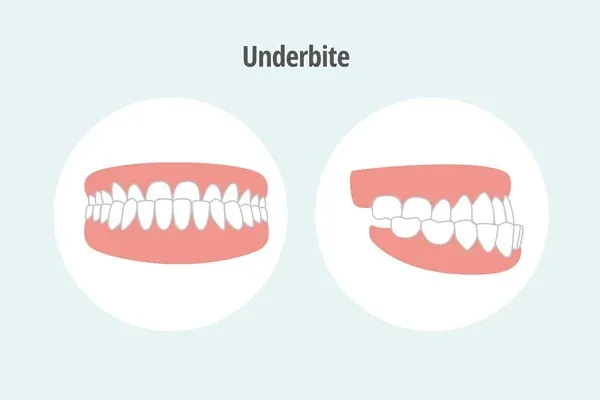Common Indications for Surgical Orthodontics
Dr. Hoss Abar
Addressing Complex Orthodontic Problems
This blog post will delve into the common indications for surgical orthodontics and how they can effectively address complex problems. Whether correcting severe malocclusions, skeletal discrepancies, or other complex dental issues, surgical orthodontics offers a comprehensive solution for patients seeking optimal oral health and a harmonious facial appearance.
Severe Malocclusion
Malocclusion is the condition when the alignment and position of teeth do not match the correct arrangement of the teeth and fixing jaws together. Class II and III malocclusions (overbite/underbite) are among the more difficult to realign teeth, and they often require jaw manipulation through surgery.
Underbite
An underbite also known as malocclusion or a "bad bite." It happens when lower teeth overlap the upper teeth. The Severity of an underbite can vary between a mild underbite, where both jaws of teeth almost intersect, and a situation wherein the teeth don't intersect at all because the gap is so broad. The leading cause of an underbite is a misalignment of the lower jaw, which usually occurs at birth.
The issues associated with an underbite depend on how severe it is. If the gap is wider, it can cause:
- Eating difficulties
- Difficulty while speaking
- Chronic jaw or joint (TMJ) pain, as well as head- and earaches
- Tooth decay from excessive wear of the tooth enamel
- Bad breath, halitosis, bacterial infections, sleep apnea, snoring, and other nighttime breathing difficulties

Crossbite
A crossbite occurs when the upper teeth close inside the lower teeth rather than the outside. This can occur due to many reasons. Most of the time, a crossbite can be genetic. However, reasons such as the use of a pacifier or thumb-sucking for long, slow loss of baby teeth, and enlarged tonsils or adenoids can be the source of a crossbite.
Facial Asymmetry
Dentofacial disproportion is a condition in which there is an imbalance in the jawbone growth. This condition can lead to misalignment of the facial features. Although this condition is beneficial for the function of the teeth, surgical orthodontics can be used to improve the appearance if the patient wishes to.
Impacted Teeth
Delayed teeth, or some of them, are teeth that do not develop properly and are stuck within the dental arch, especially canines. These teeth may need to be surgically exposed and orthodontically guided to be placed in their right position.
Open Bites and Deep Bites
- Open Bite: This occurs when the upper and lower teeth do not close when the mouth is closed due to differences in the development of the jaws in the vertical dimension. This occurs due to vertical discrepancies in the growth of the jaw. A surgical procedure can be performed to address this deformity by aligning the jaw.
- Deep Bite: A condition in which the upper front teeth extend towards the lower front teeth more than they should. Deep bites that result in severe vertical discrepancy may necessitate orthognathic surgery to alter the height of the jaws.
Obstructive Sleep Apnea
Obstructive Sleep Apnea (OSA) is a serious sleep disorder characterized by repeated interruptions in breathing during sleep due to upper airway obstruction. These interruptions, called apneas, can significantly affect sleep quality and overall health.
Factors associated with obstructive sleep apnea
OSA happens due to relaxed muscular activity in the throat during sleep. This will help the individual to unwind and close the airway, thus restricting breathing. Factors contributing to OSA include:
- Anatomical Factors: Enlarged tonsils or adenoids, thickened necks, and micrognathia can thus reduce the size of the airway.
- Obesity: Overweight individuals, especially with their neck region being overweight, are at a greater risk of becoming obstructed.
- Genetic Predisposition: Sleep apnea is also hereditary, and it can run in the family whose members are at an increased risk of suffering from it.
- Age: It is because OSA is more prevalent in older people.

- Gender: Both genders develop OSA, but men are generally at a higher risk. However, women are also at a higher risk of acquiring OSA as they age.
Common symptoms of OSA
- Loud Snoring: The most prevalent sign of illness.
- Gasping or Choking During Sleep
- Excessive Daytime Sleepiness
- Morning Headaches: The body is not exposed to the proper amount of oxygen during sleep.
- Difficulty Concentrating
- Depression and other cognitive changes.
Cleft Lip and Palate
Surgical orthodontic treatment has become part of the overall treatment modalities, and an individual with a cleft lip and palate may undergo orthodontic surgery. This requires many orthodontic and surgical treatment procedures to eliminate dental and skeletal deformations accompanying the condition.
Types of Orthognathic Surgeries
Orthognathic surgery includes a lot of surgical treatments for jaw and facial deformities. There are four types of surgeries, each designed to address specific concerns and improve the functioning and appearance of the mouth and teeth. Here are the primary types of orthognathic surgeries
Le Fort I Osteotomy
Le Fort I Osteotomy is a surgical technique applied to problems associated with the upper jaw (maxilla). In this type of surgery, the maxilla process is made to be moved in any direction, such as forward, backward, upward, or downward, by making a horizontal cut above the teeth. It is typically used to address:
- Maxillary Hypoplasia: Divergent or prognathic upper jaw.
- Vertical Maxillary Excess: Gingival hyperplasia or increased upper lip growth to cause a gummy smile.
- Open Bite Correction: LeFort I osteotomy for maxillary advancement in treating an open bite.
Bilateral Sagittal Split Osteotomy (BSSO)
BSSO, also known as mandibular sagittal split osteotomy, is a treatment for mandibular deformity. BSSO is commonly used to treat:
- Mandibular Prognathism: Underbite – an overdeveloped lower row of teeth that protrudes from the upper row.
- Mandibular Retrognathism: Receding chin and mandibular prognathism due to relative underdevelopment of the lower jaw.
Genioplasty
Genioplasty is a type of plastic surgery that changes the size and position of the chin. It is conventionally performed as an individual procedure or in combination with other jaw surgeries to improve facial aesthetics. Genioplasty is effective for:
- Chin Augmentation: Chin augmentation improves the weak or receding chin.
- Chin Reduction: The shrinking of an 'overstated' chin.
- Symmetry Correction: Correction of chin asymmetries
Segmental Osteotomy
Sectional osteotomy involves performing surgery on the jaw by dividing it into sections to treat complex dental arch distortions. It is usually performed with other orthognathic procedures to obtain optimal results. Segmental osteotomies are typically indicated for:
- Crowding: Protrusion of teeth that persists even after the third molars are removed.
- Crossbite Correction: Orthodontic treatment involves manipulating the individual segments of the jaw to the required position to place the teeth in the right positions.
Maxillomandibular Advancement (MMA)
Maxillomandibular advancement (MMA) is an open procedure that expands the oral airway. It was developed as a treatment for OSA by moving the mandible and maxilla forward. MMA moves the jaws forward, thus expanding the space behind the tongue and the soft palate, reducing airway obstruction.
Distraction Osteogenesis
Distraction is done to lengthen the bones in the jaw gradually. It involves splitting the bone with a saw and then gently bringing the cut ends together with the help of a bone spreader to allow the bone to grow slowly through the opening. This technique is often used in:
- Severe Jaw Deficiencies: When the required bone lengthening is high.
Surgical Exposure and Bonding
For impacted teeth that have not erupted naturally, the teeth are exposed surgically and bonded. This includes cutting open the impacted tooth and affixing an orthodontic bracket to move it into its desired place using braces or aligners.
These orthognathic surgeries are customized to meet the patient's specific demands. Thus, they involve the collaboration of orthodontists and oral surgeons in planning the surgery. The aim is to obtain the best possible biological and technical outcome that would benefit the patient.
Contact your Pinole dentist, Dr. Hoss Abar, DDS, MSD at Abar Orthodontics, to learn more about the Common Indications for Surgical Orthodontics.
Resource:
Can you use surgery to treat TMJ disorder?
*This media/content or any other on this website does not prescribe, recommend, or prevent any treatment or procedure. Therefore, we highly suggest that you get the advice of a qualified dentist or other medical practitioners regarding your specific dental condition.
More To Explore
About Us
We believe that every patient deserves to feel confident about their smile. Years of experience creating beautiful and flawless smiles.
Opening Hours:
Monday - Thursday: 8:00 AM - 5:00 PM
Friday: 8:00 AM - 12:00 PM
Saturday - Sunday: Closed
Abar Orthodontics, Pinole, CA
1500 Tara Hills Drive., Suite 204
Pinole, CA 94564
Abar Orthodontics, San Leandro, CA
145 East 14th street., #100
San Leandro, CA 94577
© 2025Abar Orthodontics | All rights reserved | Powered by:Vigorant, Inc.
